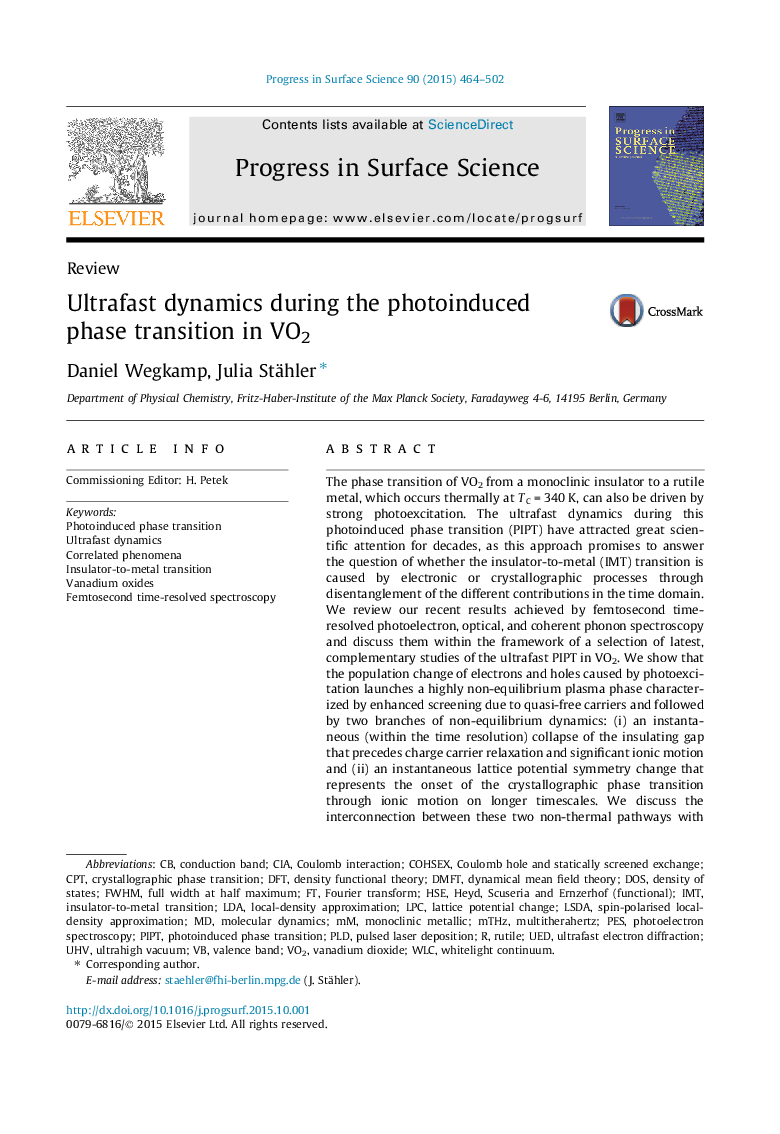| کد مقاله | کد نشریه | سال انتشار | مقاله انگلیسی | نسخه تمام متن |
|---|---|---|---|---|
| 5419936 | 1507385 | 2015 | 39 صفحه PDF | دانلود رایگان |
عنوان انگلیسی مقاله ISI
Ultrafast dynamics during the photoinduced phase transition in VO2
دانلود مقاله + سفارش ترجمه
دانلود مقاله ISI انگلیسی
رایگان برای ایرانیان
کلمات کلیدی
IMTInsulator-to-metal transitionUEDLSDAUHVDMFTWLCFWHMPLDLPCHSEVO2PESCPTDFT - DFTPhotoinduced phase transition - انتقال فاز عکس دیجیتالVanadium oxides - اکسید وانادیومconduction band - باند هدایتFourier transform - تبدیل فوریهLDA - تخصیص پنهان دیریکلهDensity of states - تراکم دولتیCoulomb interaction - تعامل کولبینLocal-density approximation - تقریبی چگالی محلیUltrahigh vacuum - خلاء فوق العاده بالاDOS - داسVanadium dioxide - دیاکسید وانادیومUltrafast dynamics - دینامیک فوق العادهMolecular dynamics - دینامیک ملکولی یا پویایی مولکولیRutile - روتیلCIA - سیاFemtosecond time-resolved spectroscopy - طیف سنجی حل شده فموستیکندphotoelectron spectroscopy - طیف سنجی فوتوالکتریکfull width at half maximum - عرض کامل در نیمی از حداکثرPulsed laser deposition - لایهنشانی یا رسوبنشانی به کمک لیزر پالسی یا سایش لیزریDensity functional theory - نظریه تابعی چگالیDynamical mean field theory - نظریه میدان متوسط پویاUltrafast electron diffraction - پراش الکترونی فوق العادهvalence band - گروه ولنتاین
موضوعات مرتبط
مهندسی و علوم پایه
شیمی
شیمی تئوریک و عملی
پیش نمایش صفحه اول مقاله

چکیده انگلیسی
The phase transition of VO2 from a monoclinic insulator to a rutile metal, which occurs thermally at TCÂ =Â 340Â K, can also be driven by strong photoexcitation. The ultrafast dynamics during this photoinduced phase transition (PIPT) have attracted great scientific attention for decades, as this approach promises to answer the question of whether the insulator-to-metal (IMT) transition is caused by electronic or crystallographic processes through disentanglement of the different contributions in the time domain. We review our recent results achieved by femtosecond time-resolved photoelectron, optical, and coherent phonon spectroscopy and discuss them within the framework of a selection of latest, complementary studies of the ultrafast PIPT in VO2. We show that the population change of electrons and holes caused by photoexcitation launches a highly non-equilibrium plasma phase characterized by enhanced screening due to quasi-free carriers and followed by two branches of non-equilibrium dynamics: (i) an instantaneous (within the time resolution) collapse of the insulating gap that precedes charge carrier relaxation and significant ionic motion and (ii) an instantaneous lattice potential symmetry change that represents the onset of the crystallographic phase transition through ionic motion on longer timescales. We discuss the interconnection between these two non-thermal pathways with particular focus on the meaning of the critical fluence of the PIPT in different types of experiments. Based on this, we conclude that the PIPT threshold identified in optical experiments is most probably determined by the excitation density required to drive the lattice potential change rather than the IMT. These considerations suggest that the IMT can be driven by weaker excitation, predicting a transiently metallic, monoclinic state of VO2 that is not stabilized by the non-thermal structural transition and, thus, decays on ultrafast timescales.
ناشر
Database: Elsevier - ScienceDirect (ساینس دایرکت)
Journal: Progress in Surface Science - Volume 90, Issue 4, December 2015, Pages 464-502
Journal: Progress in Surface Science - Volume 90, Issue 4, December 2015, Pages 464-502
نویسندگان
Daniel Wegkamp, Julia Stähler,